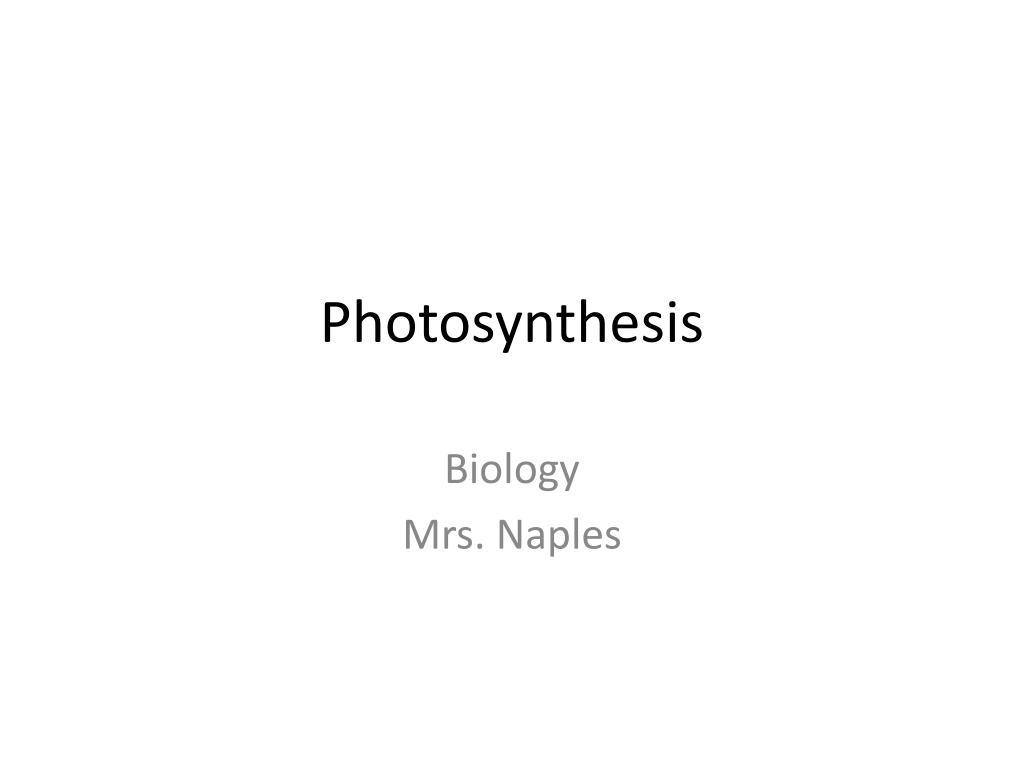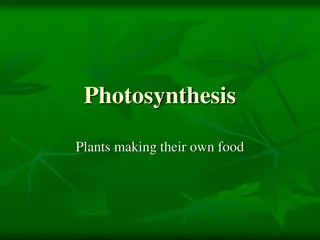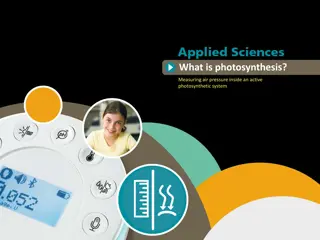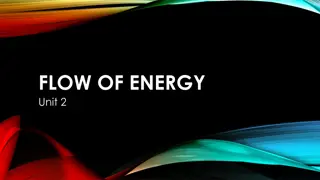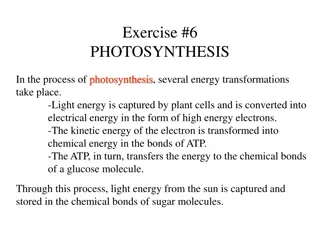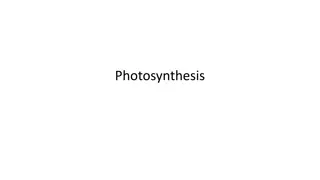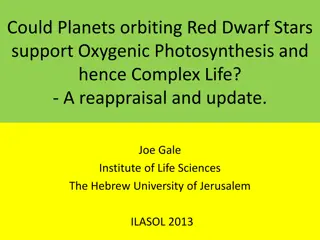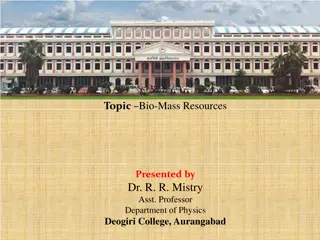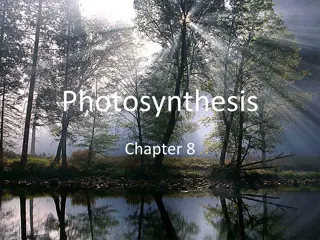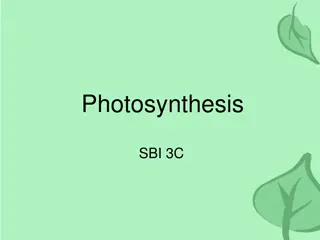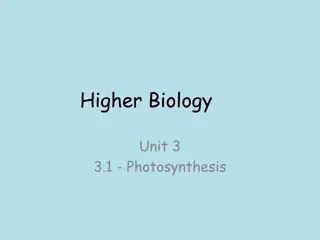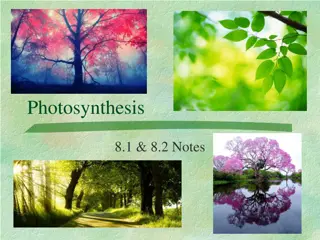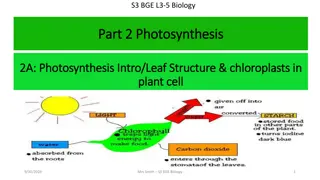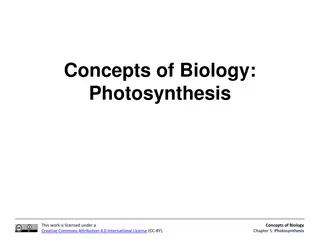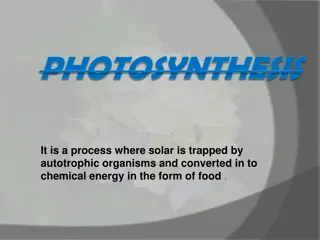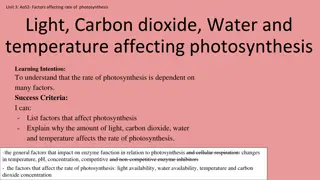Understanding Photosynthesis: The Source of Life's Energy
In the world of biology, photosynthesis is a crucial process that enables plants to harness the energy of sunlight and convert water and carbon dioxide into essential high-energy carbohydrates. This process is essential for sustaining life on Earth, as all living organisms, including humans, rely on the energy released through photosynthesis to thrive and survive. Through a series of interconnected steps and structures within plants, such as the leaf anatomy and the chemical energy of ATP, the intricate web of energy production and consumption in nature becomes clear. Understanding the significance of photosynthesis sheds light on the fundamental connection between all living things and the energy that sustains them.
Download Presentation

Please find below an Image/Link to download the presentation.
The content on the website is provided AS IS for your information and personal use only. It may not be sold, licensed, or shared on other websites without obtaining consent from the author. Download presentation by click this link. If you encounter any issues during the download, it is possible that the publisher has removed the file from their server.
E N D
Presentation Transcript
Photosynthesis Biology Mrs. Naples
Energy All living things need energy to thrive and survive We could not survive without energy Why do we need energy? Write down 2 examples of things we need energy for. _________________________ _________________________
Autotrophs and Heterotrophs Autotrophs organisms that make their own food Plants Heterotrophs organisms that obtain energy from the foods they consume Humans Catipillers Can you think of another example? _________________________________
The Sun Ultimately almost all living things get their energy from the sun. In order to live all living things MUST release energy in sugars and other compounds.
Anatomy of a Leaf Cross section of a leaf
Anatomy of a Leaf Xylem system of tubes and transport cells that circulate water and dissolved minerals throughout the plant Phloem system of tubes that transport sugars and other molecules created by the plant.(dripping sap usually comes from the phloem) Stoma a pore found in the epidermis of leaves used in the exchange of gas. Stomata release oxygen and take in carbon dioxide. They are usually open during the day and closed at night.
Stoma Stoma(also called stomata)
Chemical Energy Living things use chemical fuels One of the principal chemical fuels is ATP ATP = adenosine triphosphate ATP is made up of adenine, sugar(ribose) and phosphate groups.
Chemical Energy ADP almost the same as ATP but only has 2 phosphates
Check for Understanding What is an autotroph? What is a heterotroph? What is ATP? What is ADP? How are they alike? How are they different?
What is Photosynthesis? Key process identified in energy production Plants use the energy of sunlight to convert water and carbon dioxide into high energy carbohydrates (sugar and starch) and oxygen. Photo light Synthesis putting together Using light to put something together Chemo - chemical What do you think chemosynthesis means?
The Photosynthesis Equation Photosynthesis uses the energy of sunlight to convert water and carbon dioxide into high energy sugars and oxygen.
Capturing the Energy How do plants capture the suns light? Plants gather the sun s energy with light absorbing PIGMENTS. The plants main pigment is chlorophyll. There are two types of chlorophyll. Chlorophyll A Chlorophyll B
Capturing the Energy Chlorophyll A absorbs light in blue violet and red Chlorophyll B absorbs light in blue and red
The Color Spectrum Chart of the color spectrum
The Color Spectrum All colors are always present but can not always be seen When we see red it is because red is being reflected all other colors are being absorbed. When we see blue it is because blue is being reflected and all other colors are being absorbed. What color are you reflecting? Absorbing?
Energy from Sunlight When chloroplasts absorb light from the sun, they are also absorb energy from the sun. Much of this energy is transferred to electrons in the chlorophyll molecule which raises the energy level. This energy in the electrons is what makes photosynthesis work.
Chloroplasts A chloroplast contains sac-like membranes called thylakoids. Thylakoids are arranged in stacks called grana. Photosystems are clusters of pigment and protein that absorb light energy. Stroma region outside the thylakoid membranes.
Inside a Chloroplast The structures within a chloroplast
An Overview of Photosynthesis There are two stages of photosynthesis. The Calvin cycle which does not require light. The light dependent reactions which require light.
Light Dependent Reactions Light dependent reactions use energy from sunlight to produce ATP, NADPH and Oxygen Takes place within the thylakoid membrane of chloroplasts
Calvin Cycle Takes carbon dioxide, ATP and NADPH and creates sugar Takes place in the stroma. Does not require sunlight.
